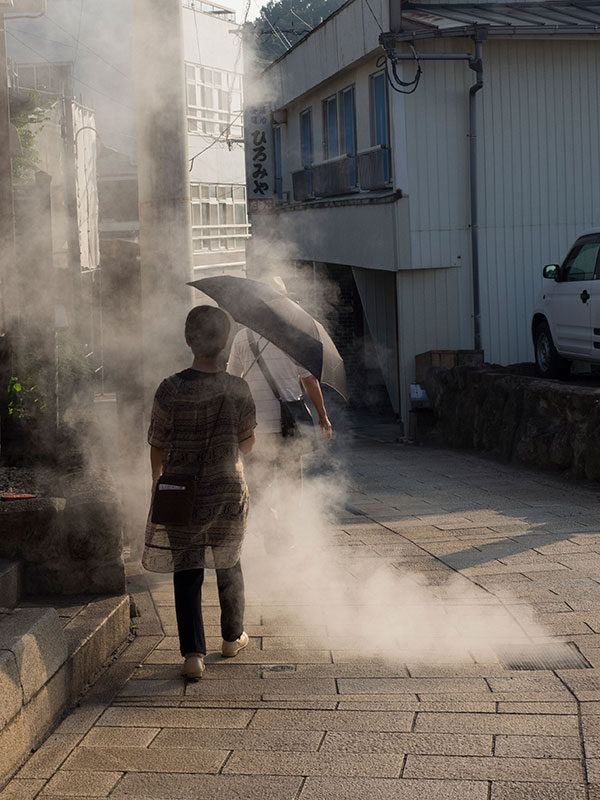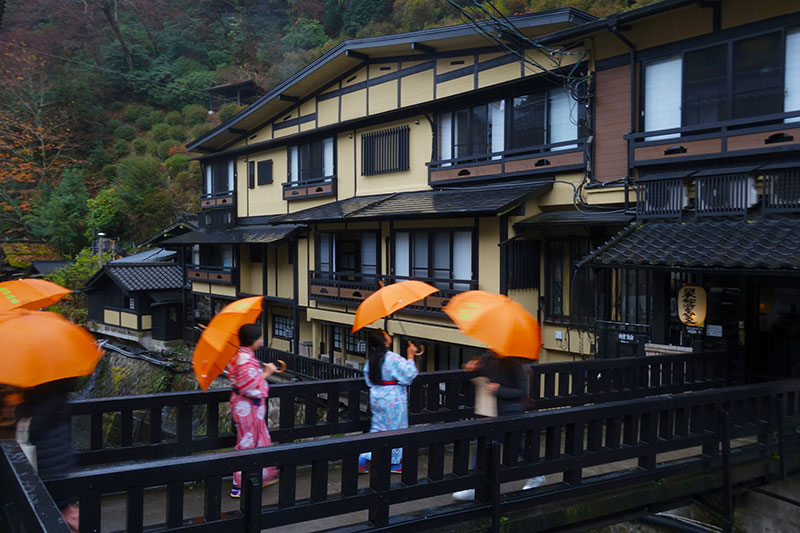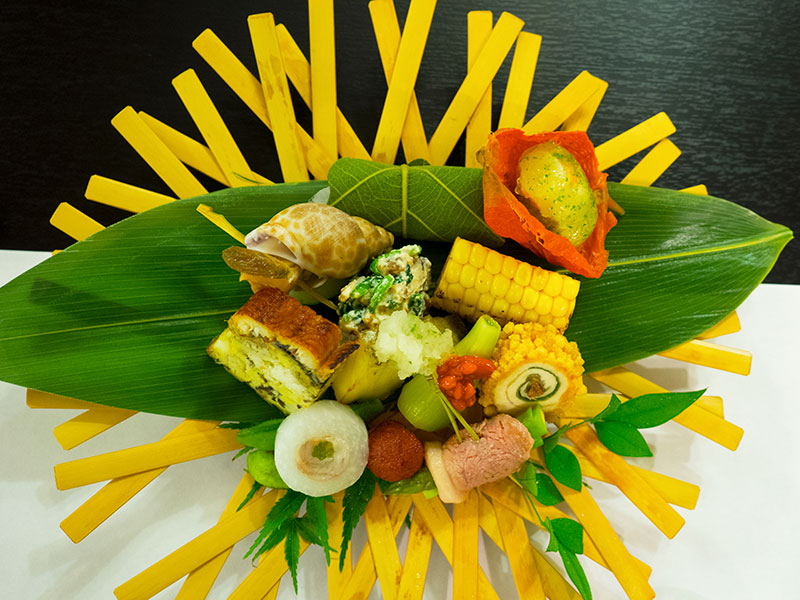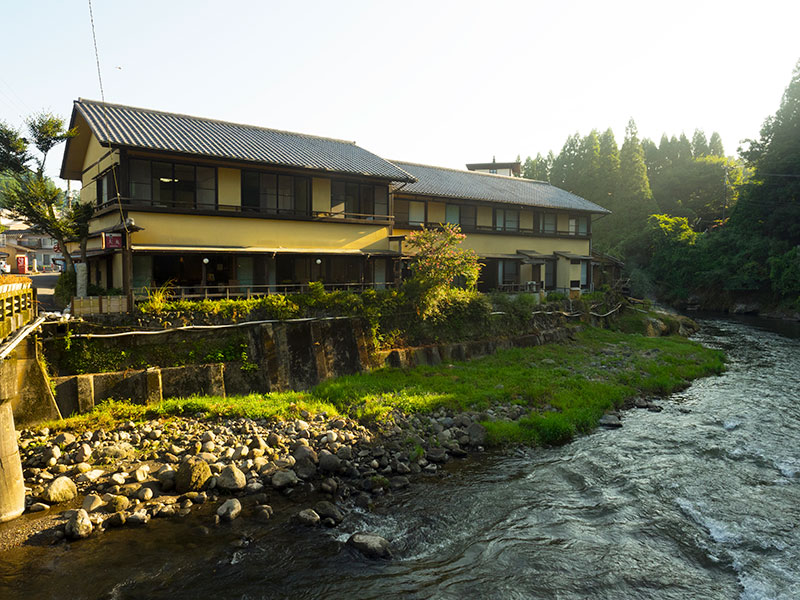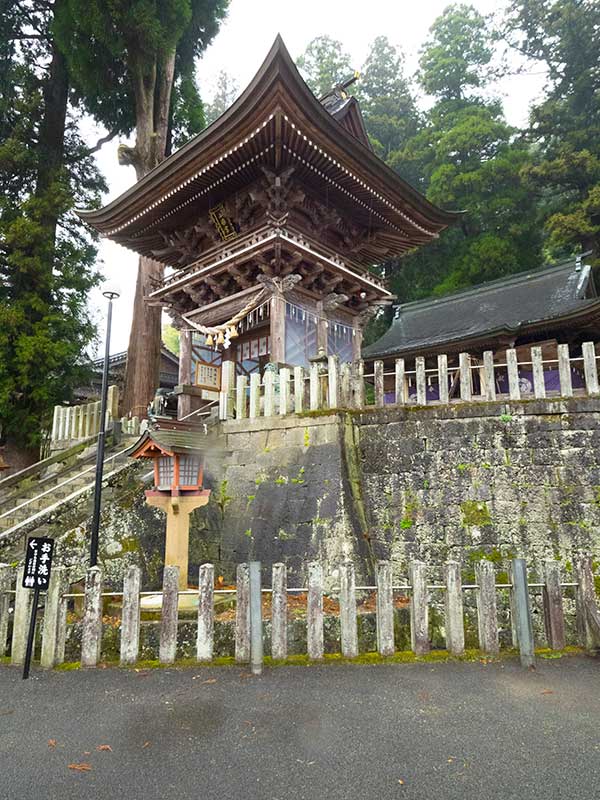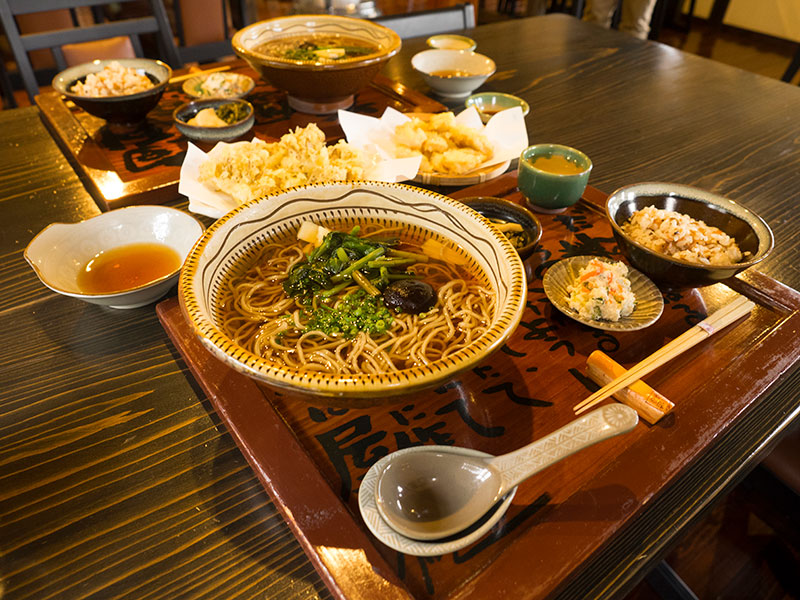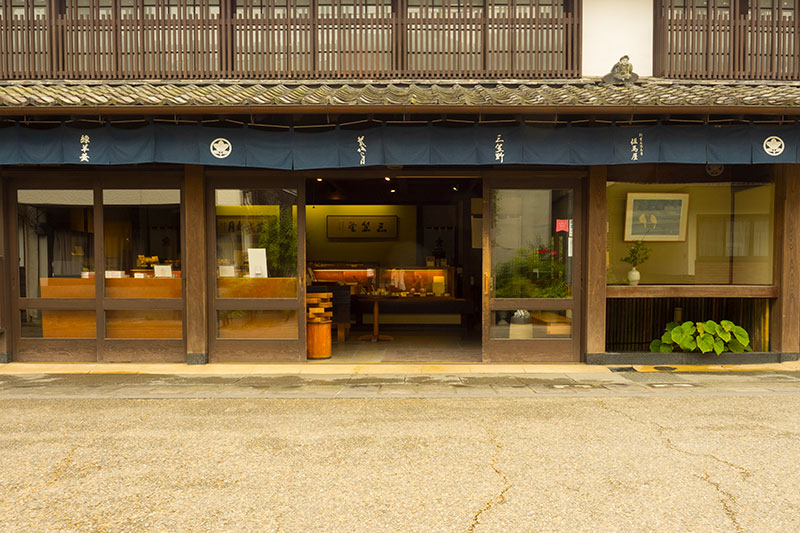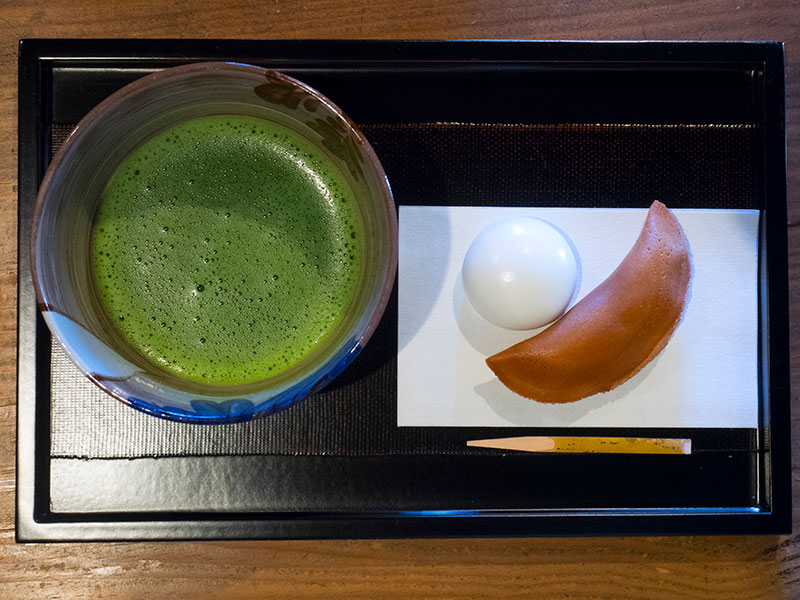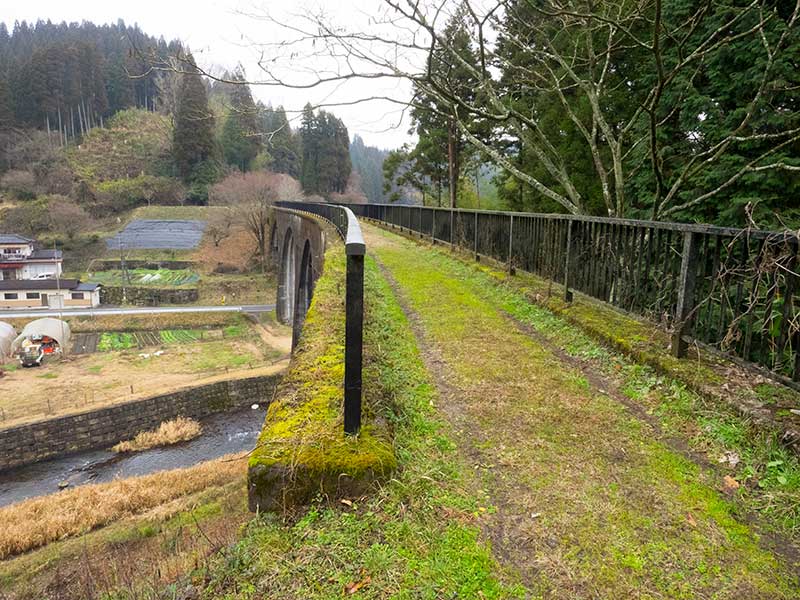An easy walking tour in rural Oita and Kumamoto Prefectures with strong emphases on onsen thermal hot springs and Japanese gastronomy.
Gentle guided walking along paths through picturesque towns and rural landscapes. Verdant valleys, pretty villages, mountain scenery, and limpid rivers. Light walking combined with plentiful onsen hot spring baths and opulent cuisine. Accommodation in lovely Japanese inns.
Year-round.
A five-day, four-night tour starting in Beppu and finishing in Oita City. Accommodation is in Japanese inns with onsen thermal hot spring baths. Please read more on accommodation here. The small intimate nature of the tour makes the maximum group size 12 people. We have no minimum size. If we accept a booking we guarantee to run the tour.
On an Onsen Gastronomy tour, in the company of an expert Walk Japan tour leader, we are immersed in the Japanese way of bathing; stay each evening in pleasant accommodations including some top hotels in the area, almost always with their own onsen; and enjoy sumptuous meals that satisfy both the eye and the stomach. Our light guided strolling allows us to thoroughly enjoy the beautiful countryside we visit and also aids digestion of the gourmet meals, delicious titbits, sakes and other drinks included in the tour.
In flavour, quality of ingredients, range of dishes, health benefits, and sheer artistry of presentation, Japanese cuisine counts amongst the world’s best. Japan’s gastronomic offerings are an appetising and convivial element of all our tours, but in the Onsen Gastronomy series of tours we take this feature to a higher level for a celebration of the quintessential Japanese art of dining.
Onsen hot springs, enjoyed on many of our tours, are found throughout the length and breadth of Japan and are one of Japan’s great attractions; a perennial favourite amongst Japanese and overseas visitors alike. Enjoyed over the millennia for their relaxing, curative and restorative powers, onsen were used in Buddhism, which first arrived in Japan in 552, for purification rites. To this day, bathing in Japan remains a ritual, an art distinctly Japanese.
This fully-guided tour visits Oita and the north-east corner of Kumamoto Prefectures in the centre of Kyushu, an area of Japan renowned for its beautiful, richly varied rural landscapes; the high quality of its food sourced from the fertile land, pristine rivers and the surrounding seas; and also for the plethora of onsen hot springs found here. It is such a wonderful combination that we would be remiss not to select this region for the first in Walk Japan’s new series of Onsen Gastronomy tours.
Oita and neighbouring Kumamoto together boast Japan’s largest concentration of onsen, which come in many different guises; some are clear and others murky, some pungent while others are fizzy. This region is a mecca for anyone who likes to luxuriate in the therapeutic thermal waters whilst experiencing the distinctive and gracious Japanese culture associated with bathing; something we enjoy morning and evening throughout the tour.
The tour starts at 1:00pm at the accommodation on Day 1 in Beppu, where your Walk Japan tour leader awaits the group. Our travels together take us first to the lanes of an old quarter of Beppu, where onsen water vapour vents forcefully skywards and seeps out from the road right under our feet. From Day 2, however, we largely leave the urban environment behind for delightful rural countryside, as we make our way from one onsen to another until the end of the tour. We follow in the footsteps of monks of old on the bucolic Kunisaki Peninsula; walk the now grassy line of a long-disused steam railway to Oguni, a quiet rural town; and explore the intriguing geo-park at Bungo-Ono. We visit Taketa, a historic town still dominated by the towering ramparts of Oka-jo, a strategic hill-top castle; and stay in upmarket Yufuin and the delightful hot spring villages of Kurokawa Onsen and Nagayu Onsen, amongst the most pleasant in Japan. On our way, we savour local food delicacies during the day and every night stay in classic Japanese ryokan inns, where we luxuriate in onsen baths before our evening meals, always a lavish feast for both eyes and stomach. We complete our journey together in Oita City for easy rail and flight connections to the rest of Japan.
Important: Please note that in Japan it has traditionally been the custom not to allow anyone with tattoos to use public baths, including onsen. Although this custom is currently being relaxed, entrance is at the discretion of each establishment. Access at additional cost is usually allowed, however, to kazoku-buro private bathing facilities, which are found at many onsen, for anyone – including those with tattoos.
Due to the culinary focus on this tour, we are unable to cater to any dietary preferences, including allergies.

Day 1 Beppu
The Walk Japan tour leader welcomes everyone to the start of the tour at 1:00pm at our accommodation in Beppu. Together we take a public bus and set off for a gentle exploration of Kannawa, an old quarter perched high up on a hill offering sweeping views on a clear day across the city, Beppu Bay and the Kunisaki Peninsula, which we visit on Day 2.
Beppu, which has more hot springs than anywhere else in Japan, takes the crown as the nation’s top onsen destination and Kannawa is very much at its onsen heart. Here, water vapour emanates continually from both vents towering above us and from grilles set in the pavement underfoot. Locals with towels in hand make their way along Kannawa’s narrow lanes throughout the day and into the evening to the many public baths found here. We may also come across some other locals at small street-side facilities preparing jigoku-mushi steamed food dishes. On our stroll we also visit some of Beppu’s famed Jigoku Onsen; ‘hells’ that are only for marvelling at and definitely not for bathing in.
It goes without saying that our accommodation has its own onsen thermal hot spring baths and we enjoy a leisurely relaxing soak before the first dinner of our tour, an extravaganza that sets the gastronomic tone for our subsequent days together.
Accommodation: Onsen hot spring resort.
Meals: Dinner provided.
Total walking: 2km (1.2 miles)
Day 2 Beppu – Kunisaki Peninsula – Yufuin
For those awake early enough, a dip in the onsen baths is a great way to start any day. Breakfast is followed by a short vehicle transfer to the neighbouring Kunisaki Peninsula, a delightful rural area known for its 1,300 year-old Rokugo-Manzan Buddhist culture. It is also the home of Walk Japan's community project, which we take time to visit and learn first-hand about rice farming and organic market gardening.
We begin our walk today at Makiodo, a temple that houses some of Japan’s most impressive Buddhist statues. A gentle stroll from here takes us through Tashibu-no-sho, a picturesque village surrounded by rice paddies and jagged cliffs. Along the way, we find stone and wooden Buddhist statues perched in caves overlooking scenery that in many ways seems to have changed little since Kunisaki’s earliest days as a Buddhist centre.
Our walk ends in time for lunch at a family-run restaurant specialising in dango-jiru, one of Oita’s original dishes. Thick kneaded wheat noodles cooked with sliced shiitake mushrooms, onions and carrots in a miso soup make this a simple, yet delicious and filling dish. Directly opposite our lunch venue is Fuki-ji temple, one of the most beautiful Buddhist structures in Japan.
After savouring Fuki-ji’s air of time-worn, tranquil beauty we transfer to Yufuin, a pleasant, upmarket onsen town centred on a small plain and towered over by Mt. Yufu-dake, an imposing, twin-peaked extinct volcano. After arrival, we go out for a gentle guided stroll around this compact town. The main street can throng with visitors browsing, shopping and just generally enjoying the atmosphere. But the back streets where we focus our exploration are, however, much less visited.
We spend the night here in a modern ryokan inn with, of course, onsen hot spring baths to relax in before dinner, a feast of local produce.
Accommodation: Modern Japanese inn with onsen hot spring baths.
Meals: Breakfast, lunch & dinner provided.
Total walking: 2.8km (1.7 miles).
Day 3 Yufuin – Oguni – Kurokawa Onsen
For those who like to rise early, a guided visit before breakfast and the crowds to Kinrinko, a small lake that is fed by onsen waters. Here, on cooler mornings, water vapour rising from the pond’s surface creates an ethereal scene.
Mid-morning we transfer by our private-hire vehicle to Oguni, just across the border in Kumamoto Prefecture. Here, we stretch our legs along a footpath that follows the line of a long disused railway, passing through verdant forested countryside sparsely interspersed with paddy fields and farmhouses. Before setting forth, however, we nourish ourselves at a local restaurant serving delicious soba buckwheat noodle dishes. Tastebuds and stomachs satiated, our gentle walk includes two tunnels and a viaduct that add an interesting frisson to the route, which ends in Oguni’s sleepy town centre. Here we find the last remaining section of rail track, which has been left as a memento at what was the site of Oguni’s once bustling rail terminus.
A short vehicle transfer brings us to Kurokawa Onsen, one of the most picturesque hot spring villages in Japan. We spend the night here in one of its top inns.
Accommodation: Traditional Japanese inn with onsen hot spring baths.
Meals: Breakfast, lunch & dinner provided.
Total walking: 5.3km (3.3 miles).
Day 4 Kurokawa Onsen – Bungo-Ono – Taketa – Nagayu Onsen
Today, we transfer by private-hire vehicle to explore Bungo-Ono, a rural district with such a wealth of geologically interesting sites that it has been designated a Geo Park by the Japanese Government.
Our first stop brings us to the beginning of our stroll. A couple of sub-shrines provide the first indication of what to expect as we make our way over a small rise to the main shrine of the area. The latter is built on a rise overlooking Harajiri-no-Taki, a horseshoe-shaped waterfall that is revered as a deity. Our destination is one of Oita’s top sake breweries, where the friendly owner encourages us to sample her excellent range of brews.
We transfer by vehicle to a ruined hill-top castle that is now a delightful park. Only stone ramparts remain, but their scale and impressiveness allude to the power that once accrued to the daimyo lord who ruled the surrounding domain from here. We walk the short distance downhill to Taketa for a stroll around this charming town and include a visit to a wagashi Japanese sweet confectioner housed in an elegant shop. We take a break here to savour delicate morsels that literally melt in the mouth.
A further vehicle transfer brings us to our accommodation for the night, a riverside inn at Nagayu Onsen. With its unspoilt charm, Nagayu Onsen competes with Kurokawa Onsen as one of the loveliest onsen resorts found anywhere in Japan. A mixed-sex bathing konyoku pool in the middle of the river is free to enter for anyone who has an outgoing disposition. Privacy is, of course, afforded at the baths in our accommodation and also at Nagayu’s unusual Lamune Onsen, which is famed for its fizzing baths of carbonated waters. Dinner is a multi-course gourmet event.
Accommodation: Traditional Japanese inn with onsen hot spring baths.
Meals: Breakfast, lunch & dinner provided.
Total walking: 5.8km (3.6 miles).
Day 5 Nagayu Onsen – Oita City
After breakfast we have time to luxuriate a final time in the onsen baths and generally enjoy Nagayu’s pleasant ambience before transferring by vehicle to Oita Station, where the tour ends around midday. Travelling to Fukuoka or other destinations in Japan is easily accomplished by train from here. Express buses also depart from the station to Oita Airport for flights to Tokyo, Osaka and Nagoya.
Accommodation: N/A.
Meals: Breakfast provided.
Total walking: N/A.
This itinerary is subject to change.
The itinerary for the Onsen Gastronomy: Oita & Kumamoto tour is ground-only, beginning in Beppu and ending in Oita City.
The airports closest to the tour’s start are Oita Airport and Fukuoka Airport. Whilst it is possible to travel by rail from Japan’s international airports in Tokyo and Nagoya to Beppu, flying to Oita is significantly faster and more convenient.
FROM OITA AIRPORT (OIT)
Take the Oita Express Airliner bus to Beppu International Tourism Port and then a taxi to the accommodation. Total journey time and cost per person is approximately 60 minutes and JPY2,500 per person. Or, take a taxi from the airport to the accommodation which is approximately 50 minutes and JPY10,000.
-----
FROM FUKUOKA INTERNATIONAL AIRPORT (FUK)
From Fukuoka International Airport, a taxi to Hakata Station costs about JPY1,500 per person and takes approximately 15 minutes. From here take the Sonic Express train to Beppu which takes approximately 120 minutes and costs JPY6,910. Take a taxi from Beppu Station to the accommodation.
-----
FROM TOKYO’S HANEDA AIRPORT (HND), TOKYO’S NARITA AIRPORT (NRT) & NAGOYA’S CENTRAL JAPAN INTERNATIONAL AIRPORT (NGO)
Transfer to the domestic terminals for flights to Oita. Take the Oita Express Airliner bus to Beppu Kitahama Bus Station and then a taxi from the adjacent taxi rank to the accommodation. Total journey time and cost per person approximately 90 minutes and JPY3,500 per person. Or, take a taxi from the airport to the accommodation which is approximately 50 minutes and JPY15,000.
-----
The pre-tour pack includes detailed instructions, including a map, for travel to the accommodation at the start of the tour.
Tour participants are advised not to book themselves out on a morning flight at the end of the tour as it does not finish until midday and the journey from Oita City to Oita Airport is approximately 90 minutes by express bus.








